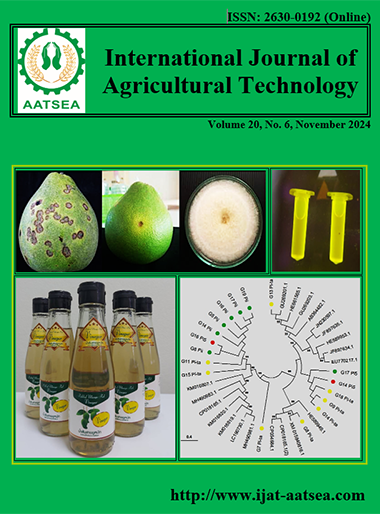Isolation and identification of endosulfan-degrading bacteria from agriculture land: A potential bioremediation approach
Main Article Content
Abstract
The findings revealed the presence of diverse bacterial populations capable of degrading endosulfan in the sampled soil. In this investigation, there are found bacterial species Acinetobacter oryzae, Flavobacterium, and Bacillus sp. which identified as potent agents for insecticide degradation. Bioremediation emerges as a compelling strategy due to its inherent eco-friendliness, cost-effectiveness, and efficiency in detoxifying pesticide-contaminated environments.
Article Details

This work is licensed under a Creative Commons Attribution-NonCommercial-NoDerivatives 4.0 International License.
References
Aislabie, J. and Lloyd-Jones, G. (1995). A review of bacterial-degradation of pesticides. Soil Research, 33:925-942.
Brady, N. C. and Weil, R. R. (2008). The nature and properties of soils. Upper Saddle River, NJ: Prentice Hall, 13:662-710.
Escher, B. I., Stapleton, H. M. and Schymanski, E. L. (2020). Tracking complex mixtures of chemicals in our changing environment. Science, 367:388-392.
Eskander, S. and Saleh, H. E. D. (2017). Biodegradation: process mechanism. Environmental Science & Engineering, 8:1-31.
Felsenstein, J. (1985). Confidence limits on phylogenies: An approach using the bootstrap. Evolution, 39:783-791.
Giri, K., Doley, B., Mishra, G., Suyal, D. C., Baruah, R. C. and Jayaraj, R. S. C. (2022). An overview of microbial diversity under diverse ecological niches in northeast India. Trends of Applied Microbiology for Sustainable Economy, 65-108.
Hagen, P. E. and Walls, M. P. (2005). The Stockholm Convention on persistent organic pollutants. Natural Resources & Environment, 19:49-52.
Kuvarega, A. T. and Taru, P. (2007). Accumulation of endosulfan in wild rat, Rattus norvegious as a result of application to soya bean in Mazoe (Zimbabwe). Environmental monitoring and assessment, 125:333-345.
Marčić, D., Perić, P. and Milenković, S. (2011). Acaricides-biological profiles, effects and uses in modern crop protection. Pesticides-formulations, effects, fate, 39-62.
Marschner, P. (2012). Rhizosphere biology. In Marschner's mineral nutrition of higher plants. Academic Press, pp.369-388.
Radhika, M. and Kannahi, M. (2014). Bioremediation of pesticide (Cypermethrin) using bacterial species in contaminated soil. International Journal of Current Microbiology and Applied Sciences, 3:427-435.
Rahman, M. A., Arefin, A. S., Saha, O. and Rahaman, M. M. (2018). Isolation and identification of pesticides degrading bacteria from farmland soil. Bangladesh Journal of Microbiology, 35:90-94.
Rahman, S., Biswas, S. K., Barman, N. C and Ferdous, T. (2016). Plant extract as selective pesticide for integrated pest management. Biotechnological research, 2:6-10.
Saitou, N. and Nei, M. (1987). The neighbor-joining method: A new method for reconstructing phylogenetic trees. Molecular Biology and Evolution, 4:406-425.
Sánchez-Bayo, F. (2012). Insecticides mode of action in relation to their toxicity to non-target organisms. The Journal, Environmental & Analytical Toxicology, S4-002.
Senthil Kumar, P., Femina Carolin, C. and Varjani, S. J. (2018). Pesticides bioremediation. Bioremediation: applications for environmental protection and management, 197-222.
Shahi Khalaf Ansar, B., Kavusi, E., Dehghanian, Z., Pandey, J., Asgari Lajayer, B., Price, G. W. and Astatkie, T. (2022). Removal of organic and inorganic contaminants from the air, soil, and water by algae. Environmental Science and Pollution Research, 1-29.
Singh, K. P., Malik, A. and Sinha, S. (2007). Persistent organochlorine pesticide residues in soil and surface water of northern Indo-Gangetic alluvial plains. Environmental monitoring and assessment, 125:147-155.
Tamura, K., Nei M. and Kumar, S. (2004). Prospects for inferring very large phylogenies by using the neighbor-joining method. Proceedings of the National Academy of Sciences (USA), 101:11030-11035.
Tamura, K., Stecher, G. and Kumar, S. (2021). MEGA 11: Molecular Evolutionary Genetics Analysis Version 11. Molecular Biology and Evolution.
Vivekanandhan, N. and Duraisamy, A. (2012). Ecological Impact of Pesticides Principally Organochlorine Insecticide Endosulfan: A Review. Universal Journal of Environmental Research & Technology, 2.
Yadav, I. C. and Devi, N. L. (2017). Pesticides classification and its impact on human and environment. Environmental science and engineering, 6:140-158.
Zhang, P., Sun, H., Min, L. and Ren, C. (2018). Biochars change the sorption and degradation of thiacloprid in soil: insights into chemical and biological mechanisms. Environmental pollution, 236:158-167.


